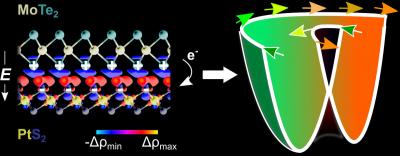Rice researchers develop theory that could push spintronics forward
A new theory by Rice University scientists could boost the field of spintronics. Materials theorist Boris Yakobson and graduate student Sunny Gupta at Rice's Brown School of Engineering describe the mechanism behind Rashba splitting, an effect seen in crystal compounds that can influence their electrons' up or down spin states, analogous to on or off in common transistors.
 The left shows the crystal structure of a MoTe2
The left shows the crystal structure of a MoTe2
The Rice model characterizes single layers to predict heteropairs two-dimensional bilayers that enable large Rashba splitting. These would make it possible to control the spin of enough electrons to make room-temperature spin transistors, a far more advanced version of common transistors that rely on electric current.